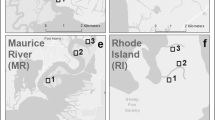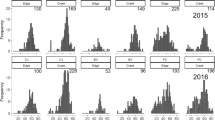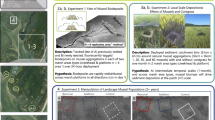Abstract
Salt marshes and their inhabitants are being displaced by climate change and human development along the coastline. One inhabitant, the ribbed mussel (Geukensia demissa), forms a mutualistic relationship with smooth cordgrass, Sporobolus alterniflorus, along the US Atlantic Coast. Ribbed mussels stabilize the marsh, remove particulate matter from the water column, and promote denitrification, thereby improving local water quality. To quantify the potential effects of SLR on ribbed mussel abundance and resulting impacts on water quality functions, we compared the current and projected future (2050) spatial distributions of ribbed mussels in Chesapeake Bay assuming an intermediate SLR for the region. We found that ribbed mussel abundance was reduced by more than half due to a combination of drowning marshes, coastal squeeze, and a shift from higher to lower quality habitat. Mussel losses were greatest along the mainstem of the Chesapeake Bay, with modest gains in the headwaters. Our results highlight the importance of permeable land cover (including living shorelines) in the future tidal extent to promote marsh transgression for future mussel populations. The projected mussel abundance reductions will result in a > 50% reduction in mussel-mediated filtration and nitrogen processing, ultimately reducing the resilience of marshes in the system.






Similar content being viewed by others
References
Angelini C, van der Heide T, Griffin JN, Morton JP, Derksen-Hooijberg M, Lamers LPM, Smolders AJP, Silliman BR (2015) Foundation species’ overlap enhances biodiversity and multifunctionality from the patch to landscape scale in southeastern United States salt marshes. Proceedings of the Royal Society B: Biological Sciences 282:20150421
Angelini C, Griffin JN, van de Koppel J, Lamers LPM, Smolders AJP, Derksen-Hooijberg M, van der Heide T, Silliman BR (2016) A keystone mutualism underpins resilience of a coastal ecosystem to drought. Nature Communications 7:12473
Baker P, Mann R (2003) Late stage bivalve larvae in a well-mixed estuary are not inert particles. Estuaries 26:837–845
Bertness MD (1984) Ribbed mussels and Spartina alterniflora production in a New England salt marsh. Ecology 65:1794–1807
Bertness MD, Grosholz E (1985) Population dynamics of the ribbed mussel, Geukensia demissa: the costs and benefits of an aggregated distribution. Oecologia 67:192–204
Bertness MD, Leonard GH (1997) The role of positive interactions in communities: lessons from intertidal habitats. Ecology 78:1976–1989
Bilkovic DM, Mitchell M, Mason P, Duhring K (2016) The role of living shorelines as estuarine habitat conservation strategies. Coastal Management 4:161–174
Bilkovic DM, Mitchell MM, Isdell RE, Schliep M, Smyth AR (2017) Mutualism between ribbed mussels and cordgrass enhances salt marsh nitrogen removal. Ecosphere 8:ecs2.1795
Boon, J. D. 2012. Evidence of sea level acceleration at U.S. and Canadian tide stations, Atlantic Coast, North America. Journal of Coastal Research 1437–1445
Boon, J. D., and M. Mitchell. 2015. Nonlinear change in sea level observed at North American tide stations. Journal of Coastal Research 1295–1305
Boon JD, Mitchell M, Loftis JD, Malmquist DM (2018) Anthropocene sea level change: a history of recent trends observed in the US East, Gulf, and West Coast Regions. Special Report in Applied Marine Science and Ocean Engineering (SRAMSOE), No. 467. Virginia Institute of Marine Science, College of William & Mary
Center for Coastal Resources Management (CCRM). 2018. Virginia shoreline inventory. Shoreline Inventory Database, Virginia Institute of Marine Science, William & Mary
Diaz RJ, Rosenberg R (2008) Spreading dead zones and consequences for marine ecosystems. Science 321:926–929
Doody JP, Williams AT (2004) ‘Coastal squeeze’ – an historical perspective. Journal of Coastal Conservation 10:129–138
Ermgassen PSE z, Spalding MD, Grizzle RE, Brumbaugh RD (2013) Quantifying the loss of a marine ecosystem service: filtration by the eastern oyster in US estuaries. Estuaries and Coasts 36:36–43
ESRI (2017) ArcMap. Environmental Systems Research Institute, Redlands, CA
Ezer T, Atkinson LP (2015) Sea level rise in Virginia–causes, effects and response. Virginia Journal of Science 66(3):8
Fagherazzi S, Anisfeld SC, Blum LK, Long EV, Feagin RA, Fernandes A, Kearney WS, Williams K (2019) Sea level rise and the dynamics of the marsh-upland boundary. Frontiers in Environmental Science 7:25
Franz DR (1996) Size and age at first reproduction of the ribbed mussel Geukensia demissa (Dillwyn) in relation to shore level in a New York salt marsh. Journal of Experimental Marine Biology and Ecology 205:(1–2):1–13
Franz DR (2001) Recruitment, survivorship, and age structure of a New York ribbed mussel population (Geukensia demissa) in relation to shore level—a nine year study. Estuaries 24:319–327
Galimany E, Wikfors GH, Dixon MS, Newell CR, Meseck SL, Henning D, Li Y, Rose JM (2017) Cultivation of the ribbed mussel (Geukensia demissa) for nutrient bioextraction in an urban estuary. Environmental Science & Technology 51(22):13311–13318
Grabowski JH, Brumbaugh RD, Conrad RF, Keeler AG, Opaluch JJ, Peterson CH, Piehler MF, Powers SP, Smyth AR (2012) Economic valuation of ecosystem services provided by oyster reefs. BioScience 62:900–909
Hardaway Jr CS, Milligan DA, Wilcox CA (2017) Shoreline evolution GIS database 1937-2017. Shoreline studies program, Virginia institute of marine science, William & Mary. http://vims-wm.maps.arcgis.com/apps/webappviewer/index.html?id=cd5cf9b788d0407fb9ba5ffb494e9bae
Henley J (2006) Huc12 -- watershed boundary dataset for 12-digit hydrologic units. US Geological Survey, Reston, VA
Honig A, Supan J, Peyre ML (2015) Population ecology of the gulf ribbed mussel across a salinity gradient: recruitment, growth and density. Ecosphere 6:1–13
IPCC. 2014. Part A: Global and Sectoral Aspects. Contribution of Working Group II to the Fifth Assessment Report of the Intergovernmental Panel on Climate Change. Page 1132 in C. B. Field, V. R. Barros, D. J. Dokken, K. J. Mach, M. D. Mastrandrea, T. E. Bilir, M. Catterjee, and Y. O. Ebi, editors. Climate Change 2014: Impacts, adaptation, and vulnerability. Cambridge University Press, Cambridge, United Kingdom and New York, NY, USA
Isdell RE, Bilkovic DM, Hershner CH (2018) Shorescape-level factors drive distribution and condition of a salt marsh facilitator (Geukensia demissa). Ecosphere 9:e02449
Jordan TE, Valiela I (1982) A nitrogen budget of the ribbed mussel, Geukensia demissa, and its significance in nitrogen flow in a New England salt marsh. Limnology and Oceanography 27:75–90
Julien AR, Tweel AW, Mcglinn DJ, Sundin GW, Hadley NH, Kingsley-Smith PR (2019) Characterization of ribbed mussel, Geukensia demissa (Dillwyn, 1817), habitat in relation to tidal elevation and salinity in a South Carolina estuary. Journal of Shellfish Research 38:53–61
Kellogg ML, Smyth AR, Luckenbach MW, Carmichael RH, Brown BL, Cornwell JC, Piehler MF, Owens MS, Dalrymple DJ, Higgins CB (2014) Use of oysters to mitigate eutrophication in coastal waters. Estuarine, Coastal and Shelf Science 151:156–168
Kemp WM, Boynton WR, Adolf JE, Boesch DF, Boicourt WC, Brush G, Cornwell JC, Fisher TR, Glibert PM, Hagy JD, Harding LW, Houde ED, Kimmel DG, Miller WD, Newell RIE, Roman MR, Smith EM, Stevenson JC (2005) Eutrophication of Chesapeake Bay: historical trends and ecological interactions. Marine Ecology Progress Series 303:1–29
Kirwan ML, Guntenspergen GR, D’Alpaos A, Morris JT, Mudd SM, Temmerman S (2010) Limits on the adaptability of coastal marshes to rising sea level. Geophysical Research Letters 37:L23401
Kirwan ML, Temmerman S, Skeehan EE, Guntenspergen GR, Fagherazzi S (2016) Overestimation of marsh vulnerability to sea level rise. Nature Climate Change 6:253–260
Kittinger JN, Ayers AL (2010) Shoreline armoring, risk management, and coastal resilience under rising seas. Coastal Management 38:634–653
Kreeger DA, Newell RIE (2001) Seasonal utilization of different seston carbon sources by the ribbed mussel, Geukensia demissa (Dillwyn) in a mid-Atlantic salt marsh. Journal of Experimental Marine Biology and Ecology 260:71–91
Kreeger DA, Gatenby CM, Bergstrom PW (2018) Restoration potential of several native species of bivalve molluscs for water quality improvement in mid-Atlantic watersheds. Journal of Shellfish Research 37(5):1121–1157
Lent CM (1969) Adaptations of the ribbed mussel, Modiolus demissus (Dillwyn), to the intertidal habitat. American Zoologist 9:283–292
Leonard LA, Croft AL (2006) The effect of standing biomass on flow velocity and turbulence in Spartina alterniflora canopies. Estuarine, Coastal and Shelf Science 69:325–336
Linker LC, Batiuk RA, Shenk GW, Cerco CF (2013) Development of the Chesapeake Bay watershed total maximum daily load allocation. JAWRA Journal of the American Water Resources Association 49:986–1006
Loosanoff VL, Davis HC (1963) Rearing of bivalve mollusks. U.S. Bureau of Commercial Fisheries Biological Laboratory. Rearing of Bivalve Mollusks, Milford, Connecticut, USA
Mitchell M, Herman J, Bilkovic DM, Hershner C (2017) Marsh persistence under sea-level rise is controlled by multiple, geologically variable stressors. Ecosystem Health and Sustainability 3:1379888
Moody J, Kreeger D (2020a) Ribbed mussel (Geukensia demissa) filtration services are driven by seasonal temperature and site-specific seston variability. Journal of Experimental Marine Biology and Ecology 522:151237
Moody, J., and D. Kreeger. 2020b. Spatial distribution of ribbed mussel (Geukensia demissa) filtration rates across the salt marsh landscape. Estuaries and Coasts
Passeri DL, Hagen SC, Medeiros SC, Bilskie MV, Alizad K, Wang D (2015) The dynamic effects of sea level rise on low-gradient coastal landscapes: a review. Earth’s Future 3:159–181
Pontee N (2013) Defining coastal squeeze: a discussion. Ocean & Coastal Management 84:204–207
QGIS.org (2019) QGIS geographic information system. Open source geospatial foundation project. http://qgis.org
R Development Core Team (2018) R: a language and environment for statistical computing. R Foundation for Statistical Computing, Vienna, Austria
Scheltema RS (1986) On dispersal and planktonic larvae of benthic invertebrates: an eclectic overview and summary of problems. Bulletin of Marine Science 39:290–322
Schieder NW, Walters DC, Kirwan ML (2018) Massive upland to wetland conversion compensated for historical marsh loss in Chesapeake Bay, USA. Estuaries and Coasts 41(4):940–951
Schuerch M, Vafeidis A, Slawig T, Temmerman S (2013) Modeling the influence of changing storm patterns on the ability of a salt marsh to keep pace with sea level rise. Journal of Geophysical Research-Earth Surface 118:84–96
Therneau TM, Atkinson EJ (1997) An introduction to recursive partitioning using the RPART routines (Vol. 61, p. 452). Mayo Foundation: Technical report
Torio DD, Chmura GL (2013) Assessing coastal squeeze of tidal wetlands. Journal of Coastal Research 290:1049–1061
US Environmental Protection Agency (2010) Chesapeake bay total maximum daily load for nitrogen, phosphorus and sediment. https://www.epa.gov/chesapeake-bay-tmdl/chesapeake-bay-tmdl-document
USACE (2014) Final feasibility report and integrated environmental assessment: main report; Lynnahaven river basin ecosystem restoration. Virginia Beach, Virginia, pp 1–283
Vogel, S. 1994. Life in moving fluids: the physical biology of flow. Princeton University Press
Wright RT, Coffin RB, Ersing CP, Pearson D (1982) Field and laboratory measurements of bivalve filtration of natural marine bacterioplankton. Limnology and Oceanography 27:91–98
Acknowledgments
The authors would like to acknowledge Julie Herman and Molly Mitchell for providing the projections of marsh extent in 2050. This manuscript was much improved by the insightful comments of Roger Mann, Megan La Peyre, Randolph Chambers, Matthias Leu, Taryn Sudol, Linda Blum, and two anonymous reviewers. Funding for this project was provided by the Office of the Associate Dean of Academic Studies at the Virginia Institute of Marine Science and NSF Coastal SEES award #1600131. This paper is Contribution No. 3926 of the Virginia Institute of Marine Science, William & Mary.
Author information
Authors and Affiliations
Corresponding author
Additional information
Publisher’s Note
Springer Nature remains neutral with regard to jurisdictional claims in published maps and institutional affiliations.
Rights and permissions
About this article
Cite this article
Isdell, R.E., Bilkovic, D.M. & Hershner, C. Large Projected Population Loss of a Salt Marsh Bivalve (Geukensia demissa) from Sea Level Rise. Wetlands 40, 1729–1738 (2020). https://doi.org/10.1007/s13157-020-01384-4
Received:
Accepted:
Published:
Issue Date:
DOI: https://doi.org/10.1007/s13157-020-01384-4




